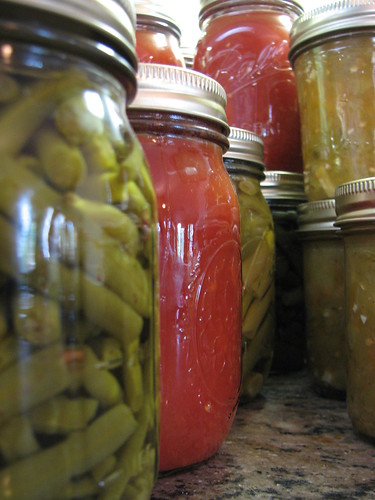Food preservation has kicked into high gear around Little Creek Farm. I had thought that selling produce at the local tailgate market would cut down on our saved produce, but it doesn't seem to have affected it all that much. We are still up to our armpits in beans and tomatoes.
The dry beans are done - I experimented again this year with a small row of Jacob's Cattle Beans. Last year Charlie picked them all, thinking they were overgrown green beans... They didn't produce as much as I had hoped (but more than last year!). A third of a row - about 10-12 feet, produced just a pound of beans. The artist in me loves these beans and the flavor is good. I might try them again in a larger row, perhaps under something taller, but I can probably use the space for something else. Drying beans is relatively easy. I just leave them on the plant until the pod (in this case the 'green bean') dries and then I pick and shell. As it can be quite damp here, I like to pick them a little early and finish the drying off the plant. Spreading the beans out in the sun on a big sheet layed on the driveway that I can easily pick up at night, or if it rains (like that ever happens...), is the simplest way to dry them. It's a trick I picked up in the Peace Corps. There's less rotting that way. Shelling can be a little time consuming, but it's a nice way to relax on a shady porch on a hot afternoon. Or, if your child is in a Montessori school, you just take in a big bag of beans and those little preschoolers will spend hours picking them out of pods, all the while developing fine motor skills the good ol' fashioned way. We don't consider it child labor, it's character development. Monkey's teachers loved it.
Canning has been an almost nightly occurence for Charlie. He loves to can. There's tomato sauce (I make it, he cans it), green beans, pickles and salsa. Canning is not so difficult (I just get bored easily, and Charlie likes it so much). I would suggest the Ball Blue Book of Preserving. Your local Cooperative Extension is also a good source for information. Tomatoes and pickles are so easy, it's almost a sin not to do it. Green beans and other low acid foods require a pressure canner that may seem intimidating, but truly isn't.





you are gonna love the dehydrator! my excaliber makes my heart sing! it's opened an whole 'nuther world of food preservation for us!
ReplyDeletelovely beans
ReplyDeleteI canned 14 pints of sour cherries yesterday. :-)
ReplyDeleteSo here's a quick question, Maggie. I have a pressure cooker. It has this thing that rattles when it's pressurey. Can I use this same cooker to pressure can? Do I need to get a different weight thing/pressure gauge than the one that just rattles faster or slower? Can one buy that part? I am so intimidated!
Gorgeous beans!
ReplyDeleteI got rid of my dehydrator. It made my electricity bill spike every time I used it. But some lucky freecycler is using it now!
Those Jacobs Cattles are gorgeous! I love everything about growing dry beans, but discovered last year that "dancing" on the dry pods really speeds up the threshing process.
ReplyDeleteI do the same "laying them out on a sheet on the driveway" which I thought I made up. And to find out that's how the pros do it in Africa. :)
jayedee - I'm liking the dehydrator a lot.
ReplyDeletent - mmm, dilly beans!
ed - thanks!
stew - I'm quite jealous about the cherries. We got ONE cherry this year - damn that freeze!
I think you need a canner/cooker with a gauge that will allow you to measure the right temperature/pressure. DO NOT be intimidated. Check with the NC Extension people - they're pretty helpful.
Bezzie - I haven't checked the electic bill to see, I've seen lovely designs for solar models, but I haven't the time (or truthfully, the desire) to build one of those.
Liz - we also use to put beans or dried corn cobs in a burlap bag and beat it with a stick - same principle, I'm sure. Only for the stuff meant for eating. For saving seed we did it by hand. :)